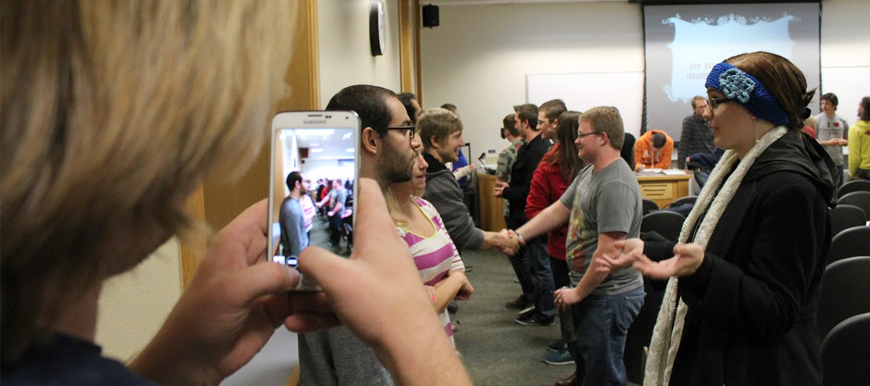Religious diversity of Utah State difficult to track
Students gathered in Old Main Tuesday night for the Interfaith Student Association’s second speed faithing event to interact with a panel of people from various religious backgrounds, including a Muslim, a Mormon, an Episcopalian, a Shoshone Native American, a Pantheist, who believes in many gods from mythology and an Asatrur, who believes in Norse gods.
Bonnie Glass-Coffin, professor of anthropology at USU and faculty advisor for the Interfaith Student Association, said understanding different religious backgrounds on campus is important because faith is a vital part of one’s identity.
“That’s one of the reasons that we’re doing this work: to try and open up spaces where we can talk about identities that we hold so dearly, but we can learn how to do so in respectful ways so that we can all share in the identity of being Aggies in a way that is good for the individuals and good for the whole,” Glass-Coffin said.
Glass-Coffin said religious diversity is relatively invisible at USU.
“Just because it’s invisible doesn’t mean that it’s not there,” Glass-Coffin said. “It means that people are choosing for whatever reason to not share that part of themselves.”
Glass-Coffin said the speed faithing events and the interfaith movement are important to make the less represented faiths visible. She said another way to be aware is to know what different faiths are on campus. However, there is no campus-wide demographic data about religious affiliation.
On the undergraduate admission and scholarship form, there is a question that asks for religious affiliation, but it is optional. The form says the question is only asked for institutional research.
“It’s nothing that is going to determine their admission here,” said Katie-Jo Nielsen, director of admissions at USU. “If it’s not going to determine their admission, I can’t ask the question.”
Nielsen said she was able to pull up demographic information about religious affiliation among incoming freshmen for the Fall 2014 semester.
“That could be done for every year, but they’re all going to change,” Nielsen said. “A lot of those religious questions change once they’re here.”
According to the demographic information obtained from Nielsen, out of 3,162 total incoming freshmen, 71 percent who answered were LDS. After that, Christian sects, including Catholic, Baptist, Methodist, Protestant, Presbyterian and Lutheran, make up 6.8 percent. Less than one percent of respondents identified as Buddhist, Hindu, Jewish and Muslim.
Only four freshmen reported being Muslim, which Ayman Afifi, a PhD student in water resources engineering and president of the Logan Islamic Center committee, said does not represent what he actually sees.
“I think there are definitely more because I know at least 10 new Muslim students who came this year,” Afifi said. “So some of them might have decided not to disclose that information for whatever reason.”
In fact, 14 percent of students chose not to volunteer their religious affiliation.
Glass-Coffin said the university will take part in a nationwide survey, which will include a discussion about religious diversity and will provide more insight into the religious demographic at USU.
“As we go in the next couple of years and have more surveys that actually ask those questions, I believe that having that information will be helpful because it will allow us to recognize, ‘Hey, there is diversity on this campus,'” Glass-Coffin said. “‘Even though it feels very LDS, there is a lot of more diversity than we’ve recognized.'”
Audrey George, a senior anthropology student who moderated at Tuesday’s speed-faithing event, said there will be another one next semester in which all the panelists will be LDS. She said diversity exists even within religions.
“Even though you have this greater ideology, this greater understanding, your life experiences will influence how you understand and interpret said doctrine,” George said.
— topherwriter@gmail.com

